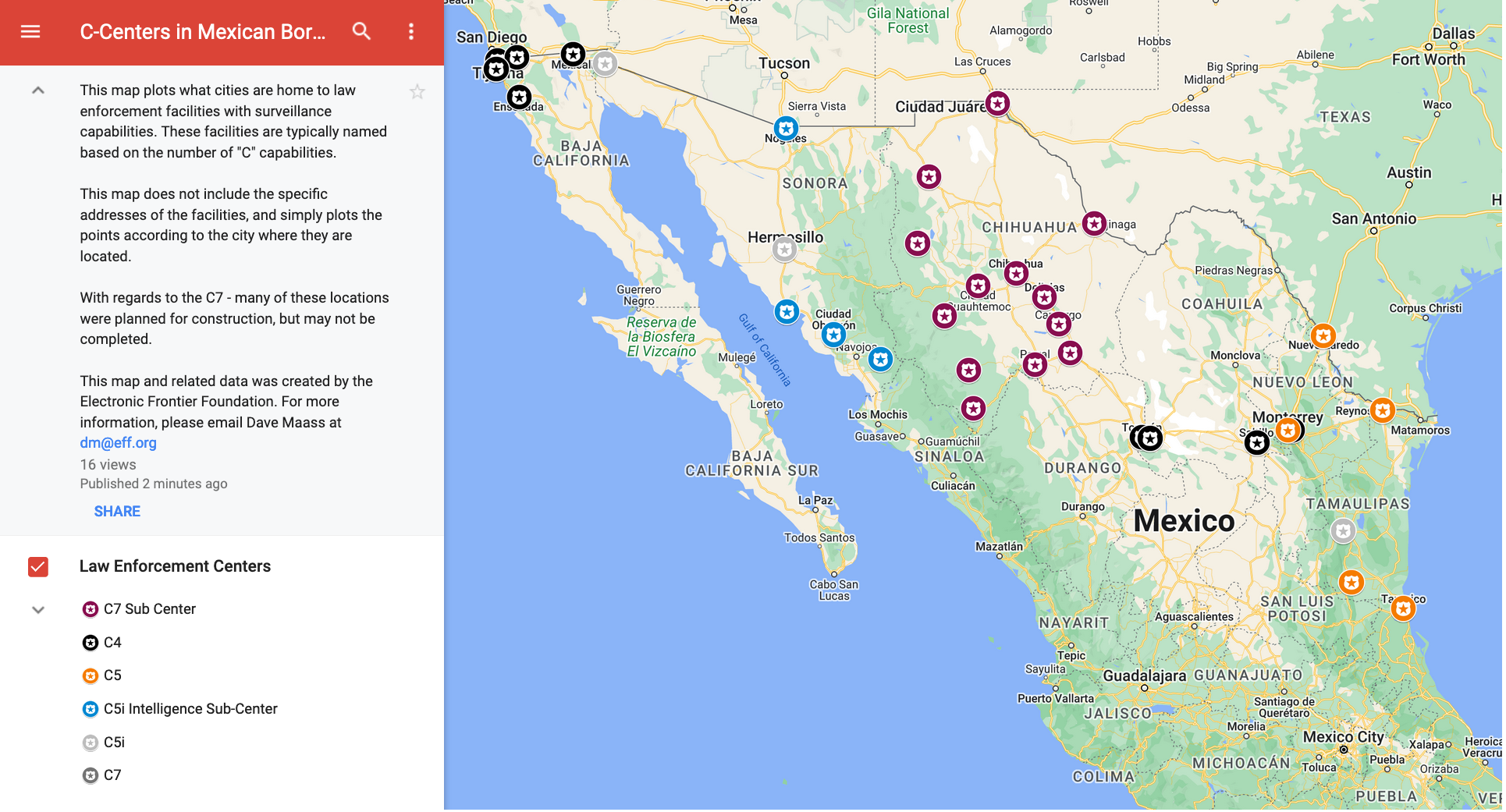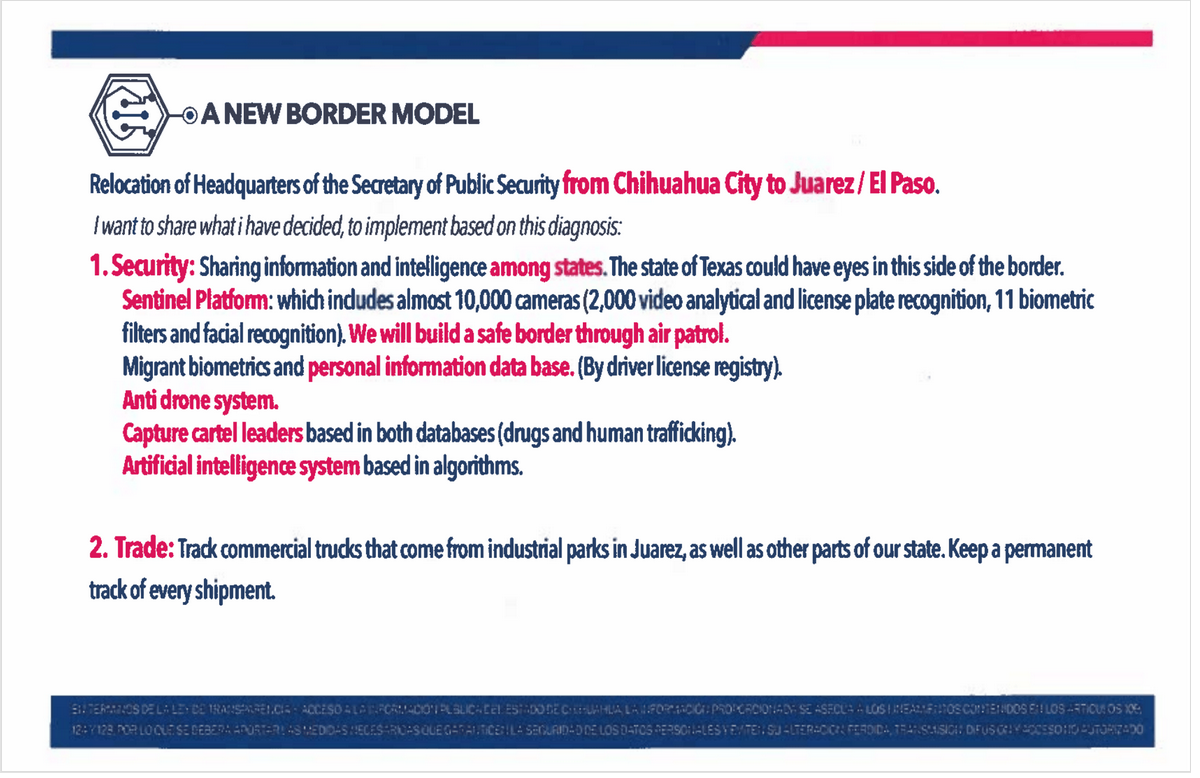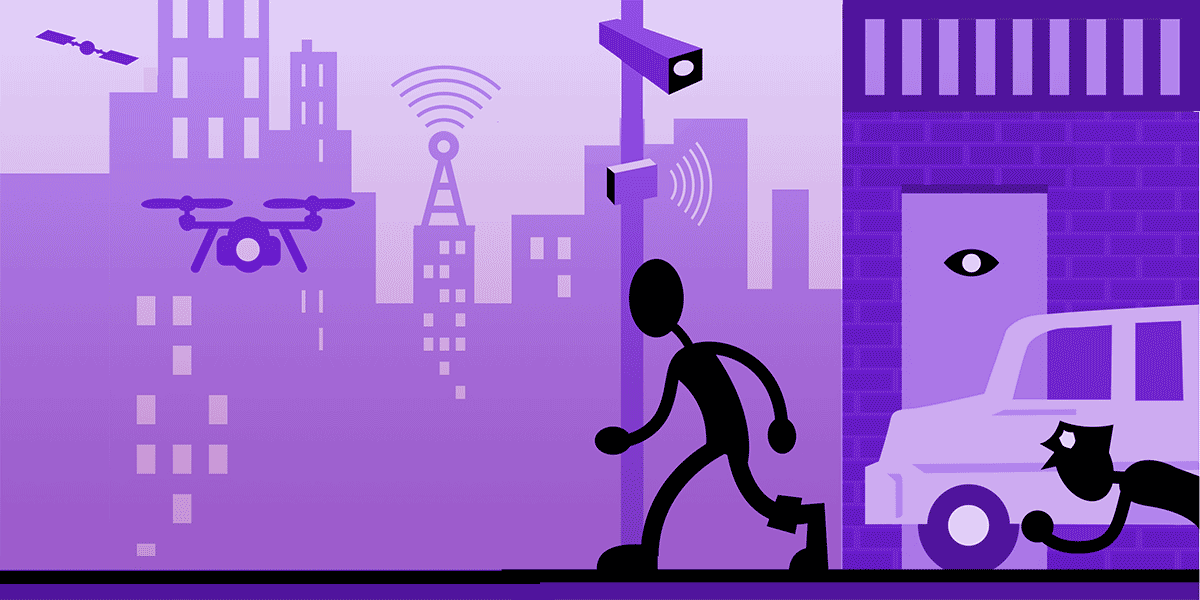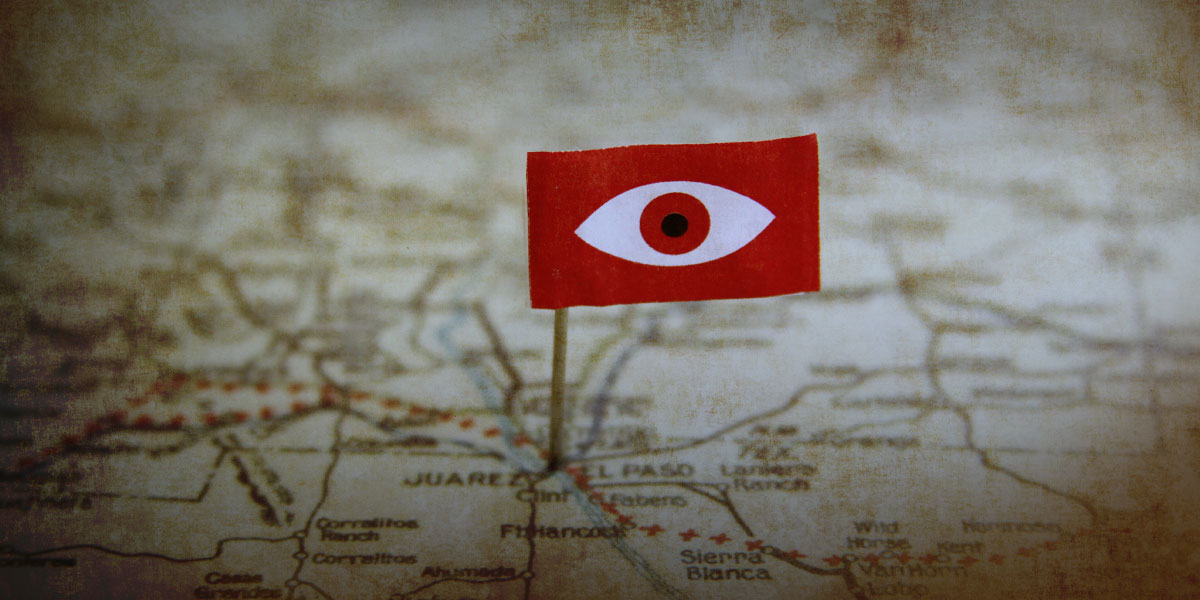EFF Special Advisor Paul Tepper and EFF intern Michael Rubio contributed research to this report.
Chihuahua state officials and a notorious Mexican security contractor broke ground last summer on the Torre Centinela (Sentinel Tower), an ominous, 20-story high-rise in downtown Ciudad Juarez that will serve as the central node of a new AI-enhanced surveillance regime. With tentacles reaching into 13 Mexican cities and a data pipeline that will channel intelligence all the way to Austin, Texas, the monstrous project will be unlike anything seen before along the U.S.-Mexico border.
And that's saying a lot, considering the last 30-plus years of surging technology on the U.S side of the border.
The Torre Centinela will stand in a former parking lot next to the city's famous bullring, a mere half-mile south of where migrants and asylum seekers have camped and protested at the Paso del Norte International Bridge leading to El Paso. But its reach goes much further: the Torre Centinela is just one piece of the Plataforma Centinela (Sentinel Platform), an aggressive new technology strategy developed by Chihuahua's Secretaria de Seguridad Pública Estatal (Secretary of State Public Security or SSPE) in collaboration with the company Seguritech.
With its sprawling infrastructure, the Plataforma Centinela will create an atmosphere of surveillance and data-streams blanketing the entire region. The plan calls for nearly every cutting-edge technology system marketed at law enforcement: 10,000 surveillance cameras, face recognition, automated license plate recognition, real-time crime analytics, a fleet of mobile surveillance vehicles, drone teams and counter-drone teams, and more.
If the project comes together as advertised in the Avengers-style trailer that SSPE released to influence public opinion, law enforcement personnel on site will be surrounded by wall-to-wall monitors (140 meters of screens per floor), while 2,000 officers in the field will be able to access live intelligence through handheld tablets.
Texas law enforcement will also have "eyes on this side of the border" via the Plataforma Centinela, Chihuahua Governor Maru Campos publicly stated last year. Texas Governor Greg Abbott signed a memorandum of understanding confirming the partnership.
Plataforma Centinela will transform public life and threaten human rights in the borderlands in ways that aren't easy to assess. Regional newspapers and local advocates–especially Norte Digital and Frente Político Ciudadano para la Defensa de los Derechos Humanos (FPCDDH)--have raised significant concerns about the project, pointing to a low likelihood of success and high potential for waste and abuse.
"It is a myopic approach to security; the full emphasis is placed on situational prevention, while the social causes of crime and violence are not addressed," FPCDDH member and analyst Victor M. Quintana tells EFF, noting that the Plataforma Centinela's budget is significantly higher than what the state devotes to social services. "There are no strategies for the prevention of addiction, neither for rebuilding the fabric of society nor attending to dropouts from school or young people at risk, which are social causes of insecurity."
Instead of providing access to unfiltered information about the project, the State of Chihuahua has launched a public relations blitz. In addition to press conferences and the highly-produced cinematic trailer, SSPE recently hosted a "Pabellón Centinel" (Sentinel Pavillion), a family-friendly carnival where the public was invited to check out a camera wall and drones, while children played with paintball guns, drove a toy ATV patrol vehicle around a model city, and colored in illustrations of a data center operator.
Behind that smoke screen, state officials are doing almost everything they can to control the narrative around the project and avoid public scrutiny.
According to news reports, the SSPE and the Secretaría de Hacienda (Finance Secretary) have simultaneously deemed most information about the project as classified and left dozens of public records requests unanswered. The Chihuahua State Congress also rejected a proposal to formally declassify the documents and stymied other oversight measures, including a proposed audit. Meanwhile, EFF has submitted public records requests to several Texas agencies and all have claimed they have no records related to the Plataforma Centinela.
This is all the more troubling considering the relationship between the state and Seguritech, a company whose business practices in 22 other jurisdictions have been called into question by public officials.
What we can be sure of is that the Plataforma Centinela project may serve as proof of concept of the kind of panopticon surveillance governments can get away with in both North America and Latin America.
What Is the Plataforma Centinela?
High-tech surveillance centers are not a new phenomenon on the Mexican side of the border. These facilities tend to use "C" distinctions to explain their functions and purposes. EFF has mapped out dozens of these in the six Mexican border states.

Click to explore the map. Google's Privacy Policy applies.
They include:
- C4 (Centro de Comunicación, Cómputo, Control y Comando) (Center for Communications, Calculation, Control, and Command),
- C5 (Centro de Coordinación Integral, de Control, Comando, Comunicación y Cómputo del Estado) (Center for Integral Coordination for Control, Command, Communications, and State Calculation),
- C5i (Centro de Control, Comando, Comunicación, Cómputo, Coordinación e Inteligencia) (Center for Control, Command, Communication, Calculation, Coordination and Intelligence).
Typically, these centers focus as a cross between a 911 call center and a real-time crime center, with operators handling emergency calls, analyzing crime data, and controlling a network of surveillance cameras via a wall bank of monitors. In some cases, the Cs may be presented in different order or stand for slightly different words. For example, some C5s might alternately stand for "Centros de Comando, Control, Comunicación, Cómputo y Calidad" (Centers for Command, Control, Communication, Computation and Quality). These facilities also exist in other parts of Mexico. The number of Cs often indicate scale and responsibilities, but more often than not, it seems to be a political or marketing designation.
The Plataforma Centinela however, goes far beyond the scope of previous projects and in fact will be known as the first C7 (Centro de Comando, Cómputo, Control, Coordinación, Contacto Ciudadano, Calidad, Comunicaciones e Inteligencia Artificial) (Center for Command, Calculation, Control, Coordination, Citizen Contact, Quality, Communications and Artificial Intelligence). The Torre Centinela in Ciudad Juarez will serve as the nerve center, with more than a dozen sub-centers throughout the state.
According to statistics that Gov. Campos disclosed as part of negotiations with Texas and news reports, the Plataforma Centinela will include:
- 1,791 automated license plate readers. These are cameras that photograph vehicles and their license plates, then upload that data along with the time and location where the vehicles were seen to a massive searchable database. Law enforcement can also create lists of license plates to track specific vehicles and receive alerts when those vehicles are seen.
- 4,800 fixed cameras. These are your run-of-the-mill cameras, positioned to permanently surveil a particular location from one angle.
- 3,065 pan-tilt-zoom (PTZ) cameras. These are more sophisticated cameras. While they are affixed to a specific location, such as a street light or a telephone pole, these cameras can be controlled remotely. An operator can swivel the camera around 360-degrees and zoom in on subjects.
- 2,000 tablets. Officers in the field will be issued handheld devices for accessing data directly from the Plataforma Centinela.
- 102 security arches. This is a common form of surveillance in Mexico, but not the United States. These are structures built over highways and roads to capture data on passing vehicles and their passengers.
- 74 drones (Unmanned Aerial Vehicles/UAVs). While the Chihuahua government has not disclosed what surveillance payload will be attached to these drones, it is common for law enforcement drones to deploy video, infrared, and thermal imaging technology.
- 40 mobile video surveillance trailers. While details on these systems are scant, it is likely these are camera towers that can be towed to and parked at targeted locations.
- 15 anti-drone systems. These systems are designed to intercept and disable drones operated by criminal organizations.
- Face recognition. The project calls for the application of "biometric filters" to be applied to camera feeds "to assist in the capture of cartel leaders," and the collection of migrant biometrics. Such a system would require scanning the faces of the general public.
- Artificial intelligence. So far, the administration has thrown around the term AI without fully explaining how it will be used. However, typically law enforcement agencies have used this technology to "predict" where crime might occur, identify individuals mostly likely to be connected to crime, and to surface potential connections between suspects that would not have been obvious to a human observer. However, all these technologies have a propensity for making errors or exacerbating existing bias.
As of May, 60% of the Plataforma Centinela camera network had been installed, with an expected completion date of December, according to Norte Digital. However, the cameras were already being used in criminal investigations.
All combined, this technology amounts to an unprecedented expansion of the surveillance state in Latin America, as SSPE brags in its promotional material. The threat to privacy may also be unprecedented: creating cities where people can no longer move freely in their communities without being watched, scanned, and tagged.
But that's assuming the system functions as advertised—and based on the main contractor's history, that's anything but guaranteed.
Who Is Seguritech?
The Plataforma Centinela project is being built by the megacorporation Seguritech, which has signed deals with more than a dozen government entities throughout Mexico. As of 2018, the company received no-bid contracts in at least 10 Mexican states and cities, which means it was able to sidestep the accountability process that requires companies to compete for projects.
And when it comes to the Plataforma Centinela, the company isn't simply a contractor: It will actually have ownership over the project, the Torre Centinela, and all its related assets, including cameras and drones, until August 2027.
That's what SSPE Secretary Gilberto Loya Chávez told the news organization Norte Digital, but the terms of the agreement between Seguritech and Chihuahua's administration are not public. The SSPE's Transparency Committee decided to classify the information "concerning the procedures for the acquisition of supplies, goods, and technology necessary for the development, implementation, and operation of the Platforma Centinela" for five years.
In spite of the opacity shrouding the project, journalists have surfaced some information about the investment plan. According to statements from government officials, the Plataforma Centinela will cost 4.2 billion pesos, with Chihuahua's administration paying regular installments to the company every three months (Chihuahua's governor had previously said that these would be yearly payments in the amount of 700 million to 1 billion pesos per year). According to news reports, when the payments are completed in 2027, the ownership of the platform's assets and infrastructure are expected to pass from Seguritech to the state of Chihuahua.
The Plataforma Centinela project marks a new pinnacle in Seguritech's trajectory as a Mexican security contractor. Founded in 1995 as a small business selling neighborhood alarms, SeguriTech Privada S.A de C.V. became a highly profitable brand, and currently operates in five areas: security, defense, telecommunications, aeronautics, and construction. According to Zeta Tijuana, Seguritech also secures contracts through its affiliated companies, including Comunicación Segura (focused on telecommunications and security) and Picorp S.A. de C.V. (focused on architecture and construction, including prisons and detention centers). Zeta also identified another SecuriTech company, Tres10 de C.V., as the contractor named in various C5i projects.
Thorough reporting by Mexican outlets such as Proceso, Zeta Tijuana, Norte Digital, and Zona Free paint an unsettling picture of Seguritech's activities over the years.
Former President Felipe Calderón's war on drug trafficking, initiated during his 2006-2012 term, marked an important turning point for surveillance in Mexico. As Proceso reported, Seguritech began to secure major government contracts beginning in 2007, receiving its first billion-peso deal in 2011 with Sinaloa's state government. In 2013, avoiding the bidding process, the company secured a 6-billion peso contract assigned by Eruviel Ávila, then governor of the state of México (or Edomex, not to be confused with the country of Mexico). During Enrique Peña Nieto's years as Edomex's governor, and especially later, as Mexico's president, Seguritech secured its status among Mexico's top technology contractors.
According to Zeta Tijuana, during the six years that Peña Nieto served as president (2012-2018), the company monopolized contracts for the country's main surveillance and intelligence projects, specifically the C5i centers. As Zeta Tijuana writes:
"More than 10 C5i units were opened or began construction during Peña Nieto's six-year term. Federal entities committed budgets in the millions, amid opacity, violating parliamentary processes and administrative requirements. The purchase of obsolete technological equipment was authorized at an overpriced rate, hiding information under the pretext of protecting national security."
Zeta Tijuana further cites records from the Mexican Institute of Industrial Property showing that Seguritech registered the term "C5i" as its own brand, an apparent attempt to make it more difficult for other surveillance contractors to provide services under that name to the government.
Despite promises from government officials that these huge investments in surveillance would improve public safety, the country’s number of violent deaths increased during Peña Nieto's term in office.
"What is most shocking is how ineffective Seguritech's system is," says Quintana, the spokesperson for FPCDDH. By his analysis, Quintana says, "In five out of six states where Seguritech entered into contracts and provided security services, the annual crime rate shot up in proportions ranging from 11% to 85%."
Seguritech has also been criticized for inflated prices, technical failures, and deploying obsolete equipment. According to Norte Digital, only 17% of surveillance cameras were working by the end of the company's contract with Sinaloa's state government. Proceso notes the rise of complaints about the malfunctioning of cameras in Cuauhtémoc Delegation (a borough of Mexico City) in 2016. Zeta Tijuana reported on the disproportionate amount the company charged for installing 200 obsolete 2-megapixel cameras in 2018.
Seguritech's track record led to formal complaints and judicial cases against the company. The company has responded to this negative attention by hiring services to take down and censor critical stories about its activities published online, according to investigative reports published as part of the Global Investigative Journalism Network's Forbidden Stories project.
Yet, none of this information dissuaded Chihuahua's governor, Maru Campos, from closing a new no-bid contract with Seguritech to develop the Plataforma Centinela project.
A Cross-Border Collaboration
The Plataforma Centinela project presents a troubling escalation in cross-border partnerships between states, one that cuts out each nation's respective federal governments. In April 2022, the states of Texas and Chihuahua signed a memorandum of understanding to collaborate on reducing "cartels' human trafficking and smuggling of deadly fentanyl and other drugs" and to "stop the flow of migrants from over 100 countries who illegally enter Texas through Chihuahua."

While much of the agreement centers around cargo at the points of entry, the document also specifically calls out the various technologies that make up the Plataforma Centinela. In attachments to the agreement, Gov. Campos promises Chihuahua is "willing to share that information with Texas State authorities and commercial partners directly."
During a press conference announcing the MOU, Gov. Abbot declared, “Governor Campos has provided me with the best border security plan that I have seen from any governor from Mexico.” He held up a three-page outline and a slide, which were also provided to the public, but also referenced the existence of "a much more extensive detailed memo that explains in nuance" all the aspects of the program.
Abbott went on to read out a summary of Plataforma Centinela, adding, "This is a demonstration of commitment from a strong governor who is working collaboratively with the state of Texas."
Then Campos, in response to a reporter's question, added: "We are talking about sharing information and intelligence among states, which means the state of Texas will have eyes on this side of the border." She added that the data collected through the Plataforma Centinela will be analyzed by both the states of Chihuahua and Texas.
Abbott provided an example of one way the collaboration will work: "We will identify hotspots where there will be an increase in the number of migrants showing up because it's a location chosen by cartels to try to put people across the border at that particular location. The Chihuahua officials will work in collaboration with the Texas Department of Public Safety, where DPS has identified that hotspot and the Chihuahua side will work from a law enforcement side to disrupt that hotspot."
In order to learn more about the scope of the project, EFF sent public records requests to several Texas agencies, including the Governor's Office, the Texas Department of Public Safety, the Texas Attorney General's Office, the El Paso County Sheriff, and the El Paso Police Department. Not one of the agencies produced records related to the Plataforma Centinela project.
Meanwhile, Texas is further beefing up its efforts to use technology at the border, including by enacting new laws that formally allow the Texas National Guard and State Guard to deploy drones at the border and authorize the governor to enter compacts with other states to share intelligence and resource to build "a comprehensive technological surveillance system" on state land to deter illegal activity at the border. In addition to the MOU with Chihuahua, Abbott also signed similar agreements with the states of Nuevo León and Coahuila in 2022.
Two Sides, One Border
The Plataforma Centinela has enormous potential to violate the rights of one of the largest cross-border populations along the U.S.-Mexico border. But while law enforcement officials are eager to collaborate and traffic data back and forth, advocacy efforts around surveillance too often are confined to their respective sides.
The Spanish-language press in Mexico has devoted significant resources to investigating the Plataforma Centinela and raising the alarm over its lack of transparency and accountability, as well as its potential for corruption. Yet, the project has received virtually no attention or scrutiny in the United States.
Fighting back against surveillance of cross-border communities requires cross-border efforts. EFF supports the efforts of advocacy groups in Ciudad Juarez and other regions of Chihuahua to expose the mistakes the Chihuahua government is making with the Plataforma Centinela and call out its mammoth surveillance approach for failing to address the root social issues. We also salute the efforts by local journalists to hold the government accountable. However, U.S-based journalists, activists, and policymakers—many of whom have done an excellent job surfacing criticism of Customs and Border Protection's so-called virtual wall—must also turn their attention to the massive surveillance that is building up on the Mexican side.
In reality, there really is no Mexican surveillance and U.S. surveillance. It’s one massive surveillance monster that, ironically, in the name of border enforcement, recognizes no borders itself.




